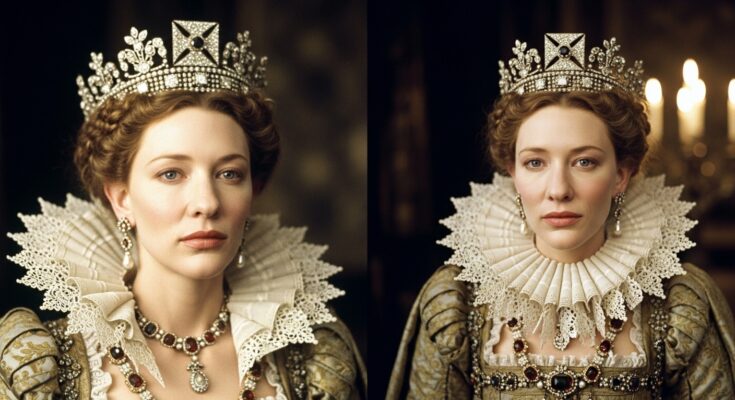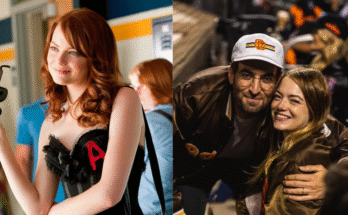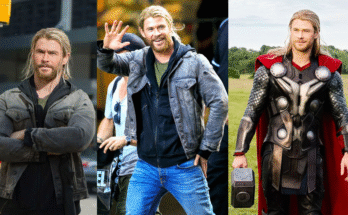“The Shapeshifter of Cinema” – From Australian Stages to World Stages
📍 ORIGINS: FROM MELBOURNE TO THE WORLD
Catherine Élise Blanchett was born on May 14, 1969 in Melbourne, Victoria, Australia. Her family background was uniquely international – her mother June Gamble was an Australian teacher and property developer, while her father Robert DeWitt Blanchett Jr. was an American advertising executive from Texas.
However, young Cate’s life took a tragic turn that would profoundly shape her character and drive her achievements. When she was just ten years old, her 40-year-old father died of a sudden heart attack.
This devastating loss could have derailed many children. Instead, her mother never remarried, and her grandmother moved in to help raise the family. The household became one of resilience, love, and unwavering support. This early experience with loss and loss combined with her mother’s strength would later inform Blanchett’s ability to portray complex, emotionally vulnerable characters.
Her childhood in suburban Melbourne exposed her to art, culture, and diverse perspectives. She developed an intellectual curiosity and love for storytelling that would eventually lead her to the stage and screen.
🎓 THE THEATRICAL FOUNDATION: NIDA AND BEYOND
Blanchett graduated from the National Institute of Dramatic Art, Australia’s most prestigious acting school. This wasn’t merely academic training – it was spiritual and artistic development at the highest level.
On graduating from NIDA, she joined the Sydney Theatre Company’s production of Caryl Churchill’s “Top Girls”. But her breakthrough came almost immediately. In 1992, Blanchett received her first stage role opposite Geoffrey Rush in the David Mamet play Oleanna, and that same year she was cast as Clytemnestra in a production of Sophocles’ Electra. When the actress playing the title role pulled out, director Lindy Davies cast Blanchett in the role, and her performance as Electra became one of her most acclaimed at NIDA.
The significance of this moment cannot be overstated. Blanchett stepped into a leading role not through years of bit parts, but through extraordinary talent and readiness. In 1993, Blanchett was awarded the Sydney Theatre Critics’ Best Newcomer Award for her performance in Timothy Daly’s Kafka Dances and won Best Actress for her performance in Mamet’s Oleanna, making her the first actor to win both categories in the same year.
At 23 years old, she had already established herself as a theatrical force of nature.
💫 THE BREAKTHROUGH: ELIZABETH AND GLOBAL STARDOM
Her breakthrough role was as young Queen Elizabeth I in the 1998 film Elizabeth, which earned her an Academy Award nomination and a Golden Globe Award for best actress. Blanchett was praised for capturing the emotional complexity of the queen’s development from a lovestruck adolescent to an indomitable political force who represses her emotional vulnerability.
This role was transformative in every sense. She married writer Andrew Upton in 1997, and they quickly married before she went off to England to play her breakthrough role in films: the title character in Elizabeth (1998) for which she won numerous awards for her performance, including the Golden Globe for Best Actress in a Drama.

Elizabeth demonstrated what Blanchett brought to cinema: psychological depth, physical presence, historical authenticity, and emotional truth. She didn’t just play Elizabeth I – she inhabited her, understood her, became her.
🎭 THE LORD OF THE RINGS: FANTASY IMMORTALITY
Following Elizabeth, Blanchett might have rested on her laurels. Instead, she took on a role in Peter Jackson’s ambitious trilogy adaptation of J.R.R. Tolkien’s masterpiece.
She found success portraying Galadriel in Peter Jackson’s epic fantasy trilogy The Lord of the Rings (2001–2003). The role of the Elf Queen became iconic, and her ethereal, commanding presence defined how millions would imagine Galadriel.
What’s remarkable about this choice is that Blanchett didn’t fear being associated with a massive commercial franchise. Many serious actors worried that genre filmmaking would diminish their artistic credibility. Blanchett proved that excellence transcends genre.
🏆 THE AVIATOR: OSCAR VICTORY AND HISTORIC ACHIEVEMENT
She won the Academy Award for Best Supporting Actress, among other honors, for portraying Katharine Hepburn in Martin Scorsese’s 2004 drama The Aviator, making her the only actor to win an Oscar for portraying another Oscar-winning actor.
This was a watershed moment. She became the first person to give an Oscar-winning portrayal of a previous Oscar winner. The achievement speaks to Blanchett’s ability to honor the source material while creating something entirely her own.
In The Aviator, working with master director Martin Scorsese, Blanchett brought Katharine Hepburn to life not as imitation but as interpretation. She captured Hepburn’s wit, her independence, her sexuality, and her strength – all while making the character feel fresh and alive.
🎪 VERSATILITY: THE MANY FACES OF CATE BLANCHETT
What distinguishes truly great actors from merely talented ones is versatility – the ability to move fluidly across genres, characters, and emotional territories without losing authenticity.
I’m Not There (2007) – The Dylan Experiment
She reprised her role as Queen Elizabeth I in the 2007 sequel Elizabeth: The Golden Age directed by Shekhar Kapur, and portrayed Jude Quinn, one of six incarnations of Bob Dylan in Todd Haynes’ experimental film I’m Not There. She won the Volpi Cup Best Actress Award at the Venice Film Festival, the Independent Spirit Award and Golden Globe Award for Best Supporting Actress for her portrayal of Jude Quinn.
This role was audacious. Playing one of six actors portraying different facets of Bob Dylan’s life and persona, Blanchett brought raw authenticity to the role. At the 80th Academy Awards, Blanchett received two nominations – Best Actress for Elizabeth: the Golden Age and Best Supporting Actress for I’m Not There – becoming the first actress to receive a second nomination with the reprisal of a role. Of her achievement that year, Roger Ebert said, “That Blanchett could appear in the same Toronto International Film Festival playing Elizabeth and Bob Dylan, both splendidly, is a wonder of acting.”

Blue Jasmine (2013) – Woody Allen’s Masterpiece
Woody Allen cast her in the title role in Blue Jasmine (2013), which won her the Academy Award as Best Actress.
As Jasmine French, a former socialite unraveling in New York, Blanchett delivered one of cinema’s great portraits of psychological decline and fragility. The character is difficult – neurotic, snobbish, yet pathetic and tragic. Blanchett found the humanity in this deeply flawed woman.
Blanchett, who also served as an executive producer of the film, drew rave reviews for her performance as the titular character, which was widely cited as one of the best of her career, alongside Elizabeth and Blue Jasmine. Justin Chang of Variety proclaimed, “As a study in the way beautiful surfaces can simultaneously conceal and expose deeper meanings, [Blanchett’s] performance represents an all-too-fitting centerpiece for this magnificently realized movie.”
Carol (2015) – Intimate Romance
She played the title role of Carol (2015), a 1950s American housewife in a lesbian affair with a younger woman, for which she received an Oscar nomination as Best Actress.
Carol required Blanchett to bring subtle, restrained emotion to a forbidden love story. Working opposite Rooney Mara, she created a portrait of a woman trapped by circumstance, longing for love in an era that forbade it.
Tár (2022) – The Conductor’s Fall
She starred in the 2022 film Tár, directed by Todd Field. For her performance, she won her second Volpi Cup for Best Actress, fourth Golden Globe Award, and fourth BAFTA Award. She also swept the major critics awards trifecta (NYFCC, LAFCA, NSFC) for the second time and went on to receive her eighth Oscar nomination, tying for the fourth most Oscar-nominated actress.
As conductor Lydia Tár, Blanchett delivered a masterclass in portraying genius and corruption intertwined. The role required her to convey musical authority, sexual magnetism, and ultimate moral collapse – all without a single false note.
🎬 ACTION AND SPECTACLE: PROVING RANGE
Blanchett refused to be confined to intimate dramas. She also demonstrated her ability to anchor large-scale action films.
She next appeared in Steven Spielberg’s Indiana Jones and the Kingdom of the Crystal Skull (2008), as the villainous KGB agent Col.
In 2015, she received praise for playing Lady Tremaine in Disney’s live action film Cinderella, Mary Mapes in Truth, and Carol Aird in Todd Haynes’s romantic drama Carol.

Later, she also played primary villain Hela in Thor: Ragnarok, bringing Shakespearean gravitas to a comic book villain. The following year, Blanchett starred in Ocean’s 8, the all-women spin-off of the Ocean’s trilogy.
🎭 RETURN TO BROADWAY AND TELEVISION
Despite her film success, Blanchett never abandoned theater. Blanchett made her Broadway debut in 2017 with The Present, receiving a Tony Award nomination for Best Actress in a Play.
Additionally, The nine-part series Mrs. America aired to widespread critical acclaim, with James Poniewozik writing in his review for The New York Times, “Her final scene, wordless and devastating, might as well end with Blanchett being handed an Emmy onscreen”; and Michael Idato for The Sydney Morning Herald proclaiming, “Blanchett’s track record speaks for itself, but here something else is happening. Every time Blanchett’s Schlafly glides perfectly into the frame, there is simply nowhere else to look.”
At the 72nd Primetime Emmy Awards, she received nominations for Outstanding Lead Actress in a Limited Series or Movie and Outstanding Limited Series, as well as nominations for the Golden Globe Award, the Screen Actors Guild Award (both for her performance), and the Television Critics Association Award for Individual Achievement in Drama.
👨👩👧👦 PERSONAL LIFE: FAMILY AND VALUES
Cate married writer Andrew Upton in 1997. She had met him a year earlier on a movie set, and they didn’t like each other at first. He thought she was aloof, and she thought he was arrogant, but then they connected over a poker game at a party, and she went home with him that night. Three weeks later he proposed marriage.
Together, they have four children. In 2015, she adopted her daughter Edith in her father’s homeland of the United States. That same year, she and her husband sold their multi-million dollar home in Australia at a profit and moved to America. Reasons varied from her wanting to work more in America to wanting to familiarize herself with her late father’s American heritage.
What’s notable about Blanchett’s life choices is that she has consistently prioritized what matters – family, meaningful work, and personal integrity. She hasn’t sacrificed her personal life for career advancement.
🌍 HUMANITARIAN WORK
The United Nations High Commissioner for Refugees (UNHCR) appointed her as a global Goodwill Ambassador.
Beyond the glitzy accolades and red carpet moments, Blanchett has used her platform to advocate for refugees and humanitarian causes. This work reveals her values extend beyond performance to real-world impact.
🏆 HISTORIC ACHIEVEMENTS AND RECORDS
Blanchett has received numerous accolades, including two Academy Awards, four British Academy Film Awards, four Golden Globe Awards and three Screen Actors Guild Awards, in addition to nominations for three Primetime Emmy Awards and a Tony Award.

She is only the sixth actress to win both leading and supporting actress Oscars. The other five are Maggie Smith, Meryl Streep, Jessica Lange, Helen Hayes and Ingrid Bergman. She holds the record as the only Australian actress to win two Academy Awards.
She is the most-nominated Australian, receiving her eighth Oscar nomination for Tár, tying for the fourth most Oscar-nominated actress.
✨ THE BLANCHETT EFFECT: WHY SHE MATTERS
What makes Cate Blanchett extraordinary isn’t simply her talent, though her talent is extraordinary. It’s her commitment to excellence across all mediums – theater, film, television. It’s her refusal to be confined by genre, age, or convention.
She proved that actresses can age beautifully on screen not by fighting aging but by taking on roles that illuminate the human condition at different life stages. While most actresses might slow down in their forties, Blanchett did the opposite by stretching her boundaries even further, such as when she played 13 different characters.
She demonstrated that commercial success and artistic integrity need not be mutually exclusive. She showed that an Australian actress could command the world stage. She revealed that a woman who values family and personal life can still achieve the highest professional accolades.
🎬 THE LEGACY AND ONGOING INFLUENCE
At 55 years old, Cate Blanchett continues to work at the highest level. She remains one of cinema’s most vital and interesting actresses. She has mentored younger actors and opened doors for Australian talent in Hollywood.
Her career serves as a template: excellence, versatility, integrity, and purpose. She has never chased fame; she has pursued meaningful work. She has never compromised her values for a role. She has balanced ambition with family, art with humanity.
In an industry that often discards women as they age, Cate Blanchett has become more powerful, more interesting, more essential with each passing year.
💡 THE BLANCHETT PHILOSOPHY
When asked what she would want if given her way, Blanchett said:
“If I had my way, if I was lucky enough, if I could be on the brink my entire life—that great sense of expectation and excitement without the disappointment—that would be the perfect state.”
This reveals something profound about Blanchett. She views life as an ongoing creative adventure. She sees each new role, each new challenge, as an opportunity for discovery rather than a chance to rest on past achievements.

She has lived this philosophy, continuously challenging herself, taking risks, and refusing to be defined by previous successes.
📊 QUICK FACTS: CATE BLANCHETT BY THE NUMBERS
Birth Date: May 14, 1969 (55 years old)
Birthplace: Melbourne, Victoria, Australia
Academy Awards: 2 (Best Supporting Actress for The Aviator; Best Actress for Blue Jasmine)
Golden Globe Awards: 4
BAFTA Awards: 4
Screen Actors Guild Awards: 3
Emmy Nominations: 2
Tony Award Nominations: 1
Oscar Nominations Total: 8 (Fourth most-nominated actress)
Volpi Cup Awards: 2
Films: 80+
Theater Productions: 20+

Years Active: 1992-present (33 years)
🎯 HER MOST ICONIC ROLES (Ranked by Impact)
Elizabeth I (Elizabeth, 1998; Elizabeth: The Golden Age, 2007)
Jasmine French (Blue Jasmine, 2013)
Katharine Hepburn (The Aviator, 2004)
Lydia Tár (Tár, 2022)
Galadriel (The Lord of the Rings Trilogy, 2001-2003)
Carol Aird (Carol, 2015)
Jude Quinn/Bob Dylan (I’m Not There, 2007)
Phyllis Schlafly (Mrs. America, 2020)
CONCLUSION: THE MASTER TRANSFORMER
Cate Blanchett is more than an actress. She is an artist who has consistently elevated cinema through her work. She is a woman who has balanced ambition with integrity, career with family, commercial success with artistic authenticity.
She has proven that excellence is achievable at every stage of life. That women can age beautifully on screen by choosing meaningful roles. That an actress from Australia can command the world stage.
Most importantly, she has shown that true artistry – whether on stage or screen – requires vulnerability, intelligence, preparation, and an unwavering commitment to truth.
In a career spanning three decades, Cate Blanchett has become one of cinema’s greatest treasures – not because she is beautiful (though she is), not because she is talented (though she is), but because she has used her gifts with wisdom, purpose, and grace.
She continues to work, continues to challenge herself, continues to remind us what acting can be at its very best.
“If you know you are going to fail, then fail gloriously!” – Cate Blanchett
And that, perhaps, is the ultimate Blanchett philosophy: Live boldly, create fearlessly, and always fail with style.



